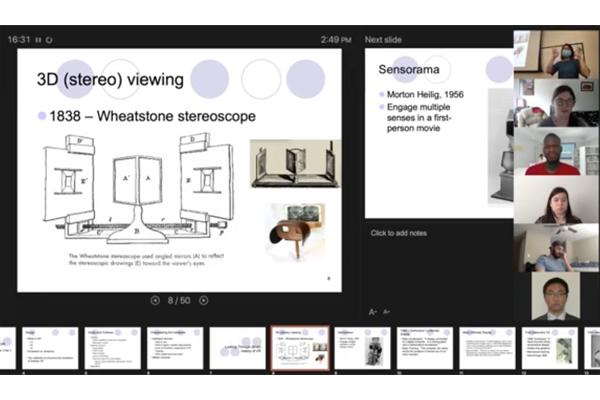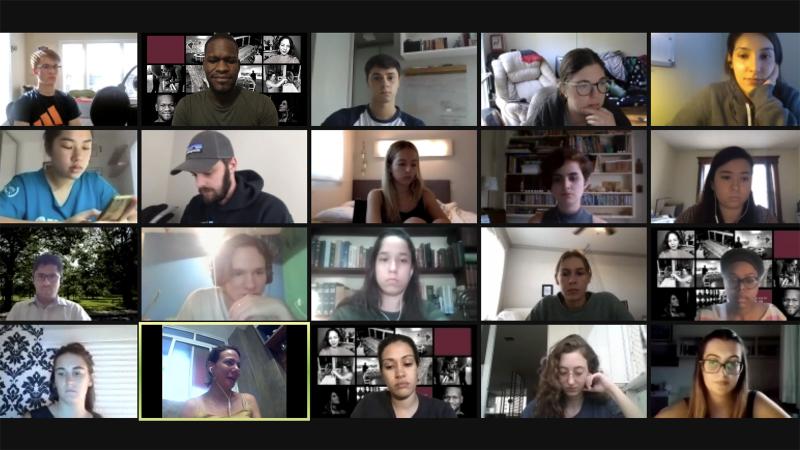ACCAD 7103 Designing Immersive Virtual Environments and CSE 5194 Teaching Collaboration

During the Autumn 2020 semester, Dr. Jian Chen (Computer Science and Engineering) and Visiting Prof. Shadrick Addy (Design/ACCAD) brought their independent virtual and augmented reality courses together in a collaborative interdisciplinary learning environment. Students enrolled in ACCAD 7103 - Designing Immersive Virtual Environments and the group study CSE 5194 - Virtual Reality Design for Science met jointly on-line throughout the semester. Co-teaching the courses allowed students to learn about the theoretical perspectives and practical application of virtual and augmented reality technology through the lenses of these respective disciplines.
As part of the 2020 Design Faculty Exhibition, "Making Lemonade," our students collaborated remotely across international borders with students from Mackenzie Presbyterian University in São Paulo, Brazil, in a week-long design charrette. During this collaboration, these students took time to learn the Brazilian culture and problems. They learned that many people in Brazil have very few resources, yet need to deal with the challenges of COVID.

From this experience, our design and computer science students worked in teams to collaboratively create "solutions" for people suffering from the social and economic impacts of the COVID-19 pandemic.
Questions and Answers
Dr. Jian Chen and Shadrick Addy responded to the questions below:
Q1: What key benefits / outcomes did your students gain from taking this collaborative teaching course?
A: Shadrick Addy – The course in the Computer Science/Data Science portion on Tuesdays introduced students to the theory and practice of virtual reality (VR) and augmented reality (AR). Students gained knowledge about the latest innovations in this field and developed an understanding of the important research issues and methodologies for VR and AR. In the Design part of the Thursday workshops students had a hands-on experience using Unity, Maya, and Blender to design immersive virtual environments and develop interaction techniques for VR and AR applications.
Students also developed skills in conceptualization, pre-production, planning, and production of working prototypes of immersive experiences. Additionally, students learned about design methods and scientific ways to create human-centered work to solve social, engineering, and scientific problems.
A: Jian Chen – One key benefit / outcome for the students was to learn how to better write and critically evaluate their proposals, to express scientific ideas clearly both in writing and orally. Teams were comprised of a design student and a computer science student. Together they researched ways to use each other's strengths to create a project that was larger than the sum of each part. For example, one team studied ways to integrate visual response, music and breath for stress reduction. Their goals were to address how each modality could contribute to the stress reduction. The CSE student worked on embodied interaction while the Design student focused on visual representation. If successful, the project would lend new design knowledge for scholars to create more effective stress reduction environments in augmented realities, an exciting yet challenging application domain.
Every week we had the opportunity to see some of the smartest young minds in our virtual zoom room. Students learned design principles, terminologies of interaction techniques from the lecture materials on Tuesdays and then implemented those ideas (using Unity) on Thursday workshops.
Q2: What were the most enjoyable & most challenging aspects of this collaboration?
A: Shadrick Addy – One of the most enjoyable aspects of our collaboration and that of the students was building on the collective strength of each other and learning from one another in the process. One person might come up with an idea that sparks creative insights among the collaborators. Through iterations and refinements, that idea becomes "a thing" that could have only been possible through the collaborative efforts of the group. Should we have taught the courses independently, the experience would have been quite different for us and the students than it was when we co-taught.
A challenging aspect of co-teaching was synthesizing the amount of information and content we had developed for our respective courses and combining them into one course. Fortunately, there were quite a few cross-overs between our pedagogical approaches and course objectives.
A: Jian Chen – An enjoyable part of this work was better understanding our students. Although officially we are their teachers, we learned from them. For instance, one team discussed language barriers across different nations and wondered if a VR project would help reduce the community gap. The students said eventually, "we live in one world." Their immense passion for wanting to make the world a better place for others is infectious. Even though students at OSU are privileged and could quickly turn their back on the impoverished, they were compelled to help others in need.
The most challenging part for us as professors was to assess our pedagogical approach. This course required integrating hands-on technologies + research all in one semester within the OSU academic framework. Another challenge was to effectively address the long-time-to-completion issues that cross-disciplinary projects require. However, seeing the process from beginning to end, with hard deadlines that forced progress, gave an introduction to and a feel for the process. In a sense, the students not only did a challenging project, they learned how to evaluate each others’ work and thus improve their own work. We anticipate that a number of students will continue their projects as graduate work and as undergraduate independent study projects or simply reuse this structured approach. Both paths permit a longer time-frame and often act as a transition to advanced degrees or research in their career.

The Challenge of Pedagogical Approach for a Multi-Discipline Course
This type of pedagogical approach presents several challenges beyond those of a single-discipline project-oriented class.
First, students need to communicate effectively with researchers in other disciplines. Communicating at different levels of abstraction is essential, because each collaboration has participants who are experts in different areas. It is impossible for all participants to understand everything at the same level of detail. This challenge is exacerbated by differences in "discipline-specific-vocabularies."
Second, significant cross-disciplinary work requires simultaneous advances in multiple disciplines; it is not enough to apply standard techniques from one discipline to problems in another.
Third, cross-disciplinary work typically takes longer, primarily because of dependencies among different parts and because of the communication and learning that must take place as part of the process.
We used a new approach in teaching this semester in a kind of collaborative guidance-revision cycle in which professors and students work on projects in multidisciplinary group settings. The approach is new because it closes the loop from idea formation to implementation to re-evaluation. The projects students worked on challenged them to think critically about their own research interests (which motivated them to join this class). The topics must leverage immersive technologies through this guidance-revision cycle. In these projects, students lead the team to create, propose, and execute a small, cross-disciplinary project during the semester, learning about each step of the technology and process itself as it arises. Students were encouraged to think big (e.g., preserve culture, facilitate social change, and address complex data science problems) but do small so they stayed focused. Diverse projects focused on education and learning, students' welling-being, and how to manage challenging social issues.
This semester's learning and teaching experience left us with poignant memories. What mattered in the end were the approaches we learned and memories of this collaboration. These students will continue making complex life (like this year of COVID 19) more simple. Their vision will invoke a better world through their inspiring immersive environments, long after they leave our zoom meetings at Ohio State University.
